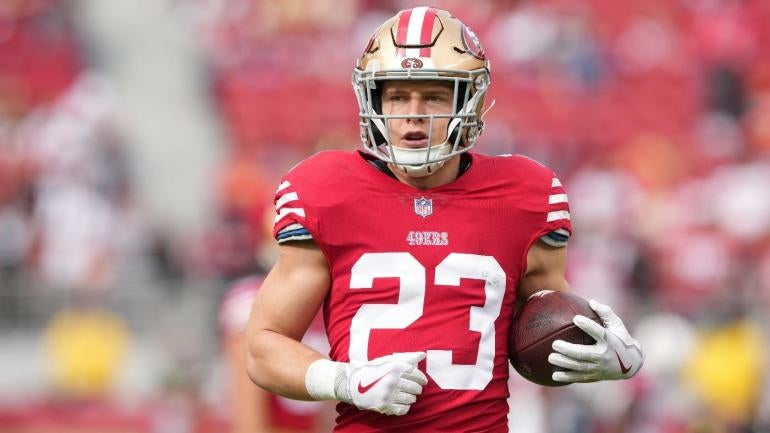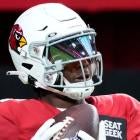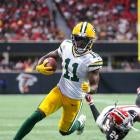
The era of going heavy on wide receivers is in full swing, and the tight end position has become stronger at the top than it has been in a long time.
Pair that with a running back slate that has added meaningful depth over the past two seasons and you'll have the makings of several pathways you can take to build your rosters this preseason.
The macro trends in football at this point are well-known, and they fit right in with what's happening in Fantasy Football. Teams are passing at high rates and using as many different people to catch passes as they can, especially when they don't have that Alpha-type receiver. This doesn't mean teams no longer like to run the ball -- they certainly will, especially if defenses continue to play zone coverage to scare offenses from throwing deep. But more teams than ever subscribe to a committee approach because it makes sense financially and structurally. Now when most teams lose a running back for a game, a month, or the season, the contingency plan is strong.

Fantasy Football Today Newsletter
Know What Your Friends Don't
Get tips, advice and news to win your league - all from the FFT podcast team.
Thanks for signing up!
Keep an eye on your inbox.
Sorry!
There was an error processing your subscription.
Implementing these concepts into Fantasy draft plans is pretty easy, but it's better to break it all down by position and lay out what you should do before you draft as well as what you might do once your draft is underway.
You'll also find my tiers for each position. I have been using them for almost two decades now as a way to sort not just who to take, but when. The tiers also show when there's a reduction in talent from one group of players to another based on expectations for Fantasy points. If you use these tiers as a baseline and then tweak them based on what you believe in and who you want to draft, you should not only be able to make easy decisions with each pick but also know in advance who you'll take with your next pick.
That makes drafting a lot less stressful and a lot more fun.
Running Back Strategy
Do you prefer hunting for running backs all season long, or loading up on the position on Draft Day so you don't have to chase them?
It's a trick question. If you're worth your salt as a Fantasy manager, you're going to be on the lookout for running backs off the waiver wire (and in trade) all season regardless of who you draft. That's even if you're one of the very lucky ones who don't have to replace an injured or underperforming running back during the year.
So if you're chasing running backs all year in all ways possible, you might as well not over-prioritize the position on Draft Day.
I think one thing you should count on, though, is the majority of your league taking one running back with their first two picks. Almost everyone will begin their draft with one receiver and one running back. That's because more and more people are gravitating toward taking the elite-level wide receivers earlier than ever (especially in PPR for obvious reasons) and avoiding an apparent logjam of receivers in the next tier, all of whom have some flaws. Taking one of each, usually with the receiver first, offers flexibility for your next few picks and balance for your roster build.
Does this mean the Hero-RB strategy is the right approach? Not. It's going to be popular but I wouldn't overlook another running back slipping into Round 2 or 3 and becoming a value pick for your roster.
So then Heavy-RB is still reasonable? It is if the value matches up. You will see at least two managers in every draft take two running backs with their first three picks, and it might even be their first two. I wouldn't blame them if there weren't wide receivers they valued when they were up in the early rounds.
Then is the Zero-RB strategy worthless? No way. You should be thrilled if you can get two elite-tier receivers with your first two picks and then follow it up with excellent values at non-RB positions with your next two picks. There will be running back values in Round 5 and beyond.
The keyword in all three of those answers? VALUE. That's the name of the game in Fantasy drafts, regardless of position. You should never pass up a value, a bargain, a steal of a deal.
That's why it doesn't make sense to commit to one of the three common running back strategies before your draft. You should know about them and be open to all three of them, and maybe prefer one of them to the others, but let the draft dictate which path you take.
Regardless of these scenarios, I still think it's worth it to finish your draft with as many as seven running backs on your squad. Take as many shots as you can on runners who can become starters. You'd rather begin the year with them on your team than the waiver wire.
Pre-draft homework:
* Do receptions count for a full point? If they don't then you should prioritize running backs immediately. You could do the same in half-point PPR, too.
* Figure out where the elite running backs end in your mind and the startable-but-not-as-good running backs begin. For me, Tier 4 is where the first big drop-off is, then another at Tier 6. You're going to want running backs before these tiers run out ... unless you don't because you love Zero-RB.
* Take some time to target three or four late-round running backs. Look for guys in strong offenses who have an older runner in front of them, or an unproven runner in front of them. Some suggestions: Blake Corum, Trey Benson, Chase Brown, Kimani Vidal, Ty Chandler, Jaleel McLaughlin, Kendre Miller and Elijah Mitchell.
Running back PPR tiers
B. Hall
NYJ
Breece Hall
NYJ
|
B. Robinson
ATL
Bijan Robinson
ATL
|
J. Gibbs
DET
Jahmyr Gibbs
DET
|
J. Taylor
IND
Jonathan Taylor
IND
|
S. Barkley
PHI
Saquon Barkley
PHI
|
K. Williams
LAR
Kyren Williams
LAR
|
T. Etienne
JAC
Travis Etienne
JAC
|
I. Pacheco
KC
Isiah Pacheco
KC
|
D. Henry
BAL
Derrick Henry
BAL
|
R. White
TB
Rachaad White
TB
|
J. Jacobs
GB
Josh Jacobs
GB
|
J. Cook
BUF
James Cook
BUF
|
A. Kamara
NO
Alvin Kamara
NO
|
D. Achane
MIA
De'Von Achane
MIA
|
K. Walker III
SEA
Kenneth Walker III
SEA
|
D. Montgomery
DET
David Montgomery
DET
|
Z. White
LV
Zamir White
LV
|
J. Conner
ARI
James Conner
ARI
|
J. Brooks
CAR
Jonathon Brooks
CAR
|
N. Harris
PIT
Najee Harris
PIT
|
T. Pollard
TEN
Tony Pollard
TEN
|
A. Jones
MIN
Aaron Jones
MIN
|
D. Swift
CHI
D'Andre Swift
CHI
|
R. Mostert
MIA
Raheem Mostert
MIA
|
T. Spears
TEN
Tyjae Spears
TEN
|
J. Williams
DEN
Javonte Williams
DEN
|
N. Chubb
CLE
Nick Chubb
CLE
|
B. Robinson Jr.
WAS
Brian Robinson Jr.
WAS
|
A. Ekeler
WAS
Austin Ekeler
WAS
|
D. Singletary
NYG
Devin Singletary
NYG
|
J. Warren
PIT
Jaylen Warren
PIT
|
G. Edwards
LAC
Gus Edwards
LAC
|
B. Corum
LAR
Blake Corum
LAR
|
J. Ford
CLE
Jerome Ford
CLE
|
E. Elliott
DAL
Ezekiel Elliott
DAL
|
C. Brown
CIN
Chase Brown
CIN
|
T. Benson
ARI
Trey Benson
ARI
|
K. Vidal
LAC
Kimani Vidal
LAC
|
Z. Charbonnet
SEA
Zach Charbonnet
SEA
|
T. Chandler
MIN
Ty Chandler
MIN
|
J. McLaughlin
DEN
Jaleel McLaughlin
DEN
|
M. Lloyd
GB
MarShawn Lloyd
GB
|
E. Mitchell
SF
Elijah Mitchell
SF
|
J. Dobbins
LAC
J.K. Dobbins
LAC
|
K. Miller
NO
Kendre Miller
NO
|
C. Hubbard
CAR
Chuba Hubbard
CAR
|
B. Irving
TB
Bucky Irving
TB
|
T. Tracy Jr.
NYG
Tyrone Tracy Jr.
NYG
|
A. Gibson
NE
Antonio Gibson
NE
|
A. Estime
DEN
Audric Estime
DEN
|
Running back non-PPR tiers
B. Hall
NYJ
Breece Hall
NYJ
|
B. Robinson
ATL
Bijan Robinson
ATL
|
J. Gibbs
DET
Jahmyr Gibbs
DET
|
J. Taylor
IND
Jonathan Taylor
IND
|
S. Barkley
PHI
Saquon Barkley
PHI
|
D. Henry
BAL
Derrick Henry
BAL
|
K. Williams
LAR
Kyren Williams
LAR
|
T. Etienne
JAC
Travis Etienne
JAC
|
I. Pacheco
KC
Isiah Pacheco
KC
|
J. Jacobs
GB
Josh Jacobs
GB
|
R. White
TB
Rachaad White
TB
|
D. Achane
MIA
De'Von Achane
MIA
|
J. Cook
BUF
James Cook
BUF
|
A. Kamara
NO
Alvin Kamara
NO
|
K. Walker III
SEA
Kenneth Walker III
SEA
|
D. Montgomery
DET
David Montgomery
DET
|
Z. White
LV
Zamir White
LV
|
J. Conner
ARI
James Conner
ARI
|
J. Brooks
CAR
Jonathon Brooks
CAR
|
T. Pollard
TEN
Tony Pollard
TEN
|
N. Harris
PIT
Najee Harris
PIT
|
A. Jones
MIN
Aaron Jones
MIN
|
R. Mostert
MIA
Raheem Mostert
MIA
|
T. Spears
TEN
Tyjae Spears
TEN
|
J. Williams
DEN
Javonte Williams
DEN
|
N. Chubb
CLE
Nick Chubb
CLE
|
G. Edwards
LAC
Gus Edwards
LAC
|
B. Robinson Jr.
WAS
Brian Robinson Jr.
WAS
|
A. Ekeler
WAS
Austin Ekeler
WAS
|
D. Singletary
NYG
Devin Singletary
NYG
|
B. Corum
LAR
Blake Corum
LAR
|
J. Warren
PIT
Jaylen Warren
PIT
|
E. Elliott
DAL
Ezekiel Elliott
DAL
|
T. Benson
ARI
Trey Benson
ARI
|
C. Brown
CIN
Chase Brown
CIN
|
J. Ford
CLE
Jerome Ford
CLE
|
K. Vidal
LAC
Kimani Vidal
LAC
|
T. Chandler
MIN
Ty Chandler
MIN
|
J. McLaughlin
DEN
Jaleel McLaughlin
DEN
|
Z. Charbonnet
SEA
Zach Charbonnet
SEA
|
M. Lloyd
GB
MarShawn Lloyd
GB
|
E. Mitchell
SF
Elijah Mitchell
SF
|
K. Miller
NO
Kendre Miller
NO
|
J. Dobbins
LAC
J.K. Dobbins
LAC
|
A. Gibson
NE
Antonio Gibson
NE
|
C. Hubbard
CAR
Chuba Hubbard
CAR
|
A. Estime
DEN
Audric Estime
DEN
|
B. Irving
TB
Bucky Irving
TB
|
T. Tracy Jr.
NYG
Tyrone Tracy Jr.
NYG
|
Which sleepers, breakouts and busts should you target and fade, and which RB shocks the NFL with a top-10 performance? Visit SportsLine now to get cheat sheets for every single position, all from the model that nailed Deebo Samuel as a bust last year, and find out.

















